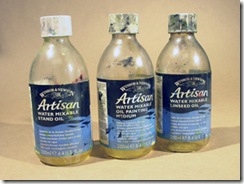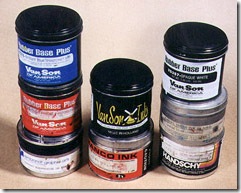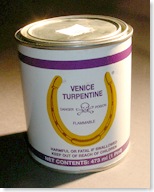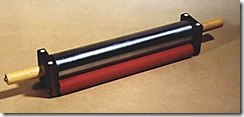A good lithographic printer probably can make most traditional oil based inks available to them work in this process, but some new inks can make printing much easier. Hand printing with waterless plates requires ink with a good amount of tack, but traditional printers normally want less tack, so ink makers keep it low. Greasy inks that were great for traditional stone and plates simply produce a large amount of background tinting so I would not recommend using these old favourites.
Luckily I was in the habit of using Van Son Rubber Base Plus ink as far back as the late 1950’s and had a good range of colours in my studio. This Dutch companies ink came on the North American market about that time, giving me a perfect ink with no drier, which I needed for the stones and plates I was using in my printmaking. When I started to do research into my waterless process in 1990, I thought fine art printmakers would reject this commercial ink, so I recommended others from their accepted list. Only after a New York art printer confessed about what he was using for traditional printing, that I started to recommend Van Son as one of the best ink for waterless plates.
Van Son makes a number of lithographic inks but the Rubber Base Plus is the one that will print cleanly many times right out of the can. It stays opened on the ink slab and doesn’t skin in the can. Colours are richer than other popular art printer inks and have passed a simple lightfastness test better than most. Luckily for printmakers, Van Son inks seem to be available worldwide. Now Van Son and other major ink makers have started to produce special ink for commercial waterless offset printers, but the ones I have tried have too much drier that produces just as many other problems as the ink overcomes. Some have even developed waterbased waterless ink for commercial printers, but driers are still a big problem from the two produces I have tried.
There is a big push by printmakers to find good waterbased inks so they don’t need hydrocarbons for cleaning up after printing. After doing a fair amount of research into this problem by trying to modify the regular inks in my studio, I have started to wonder if all that effort was in vain. Common oil based ink by itself is not toxic as it does not have any VOC’s to speak of, it is the hydrocarbons used at cleanup. What I had been trying was to make the ink somewhat emulsified by using common surfactants etc., but in the end I believe that there are many good industrial degreasers that can remove ink safely. Presently I have a number of simple mixtures that will do as good job of cleaning slab and rollers if given a chance by removing most of the ink first. I will cover all this better at some later time.
Offset printers found that when they started waterless jobs, the plates would start taking on ink over the non-printing areas as the ink got warmer in the assembled ink rollers on the press. The fountain solutions used in traditional offset had kept the plate cool as the water evaporated. Some traditional offset presses have refrigeration built into the plate cylinders to keep ink temperatures down, but even this was not good enough for the early waterless printers. Eventually special presses or conversions were developed for their industry, as well as great strides were made in ink formulation.
Ink Modifiers
While many times Van Son ink straight out of the can print perfectly, other times some modification will makes things easier while printing. Tinting on the plate background is the common problem for waterless even though we do not have the heat build up problem by hand rolling. To overcome this the first step is to use a smaller diameter roller as the snap it produces tend to lift the ink off better from the background. Stiffening the ink with magnesium carbonate is one helpful solution, but I prefer using the hardener from regular epoxy adhesive as it doesn’t reduce tack. To increase tack, I have developed a modifier from Venice turpentine and body gum, for which a page can be found in my website at the University of Saskatchewan: <http://homepage.usask.ca/~nis715/>.
 I also use low number litho varnishes or water reducible linseed oil made by Windsor & Newton for their waterbased oil paint. This is to get back into a usable ink if too much epoxy hardener is used, which can make the ink unprintable. Since I have a large variety of ink collected over the many years of printing, I use them to modify any ink by the characteristics of the available inks. I have acquired a big batch of offset inks for waterless presses and use them when ever I can because I have so much - a total of 65 pound! While the driers are a big problem, I have found ways to slow drying enough to finish putting on a colour.
I also use low number litho varnishes or water reducible linseed oil made by Windsor & Newton for their waterbased oil paint. This is to get back into a usable ink if too much epoxy hardener is used, which can make the ink unprintable. Since I have a large variety of ink collected over the many years of printing, I use them to modify any ink by the characteristics of the available inks. I have acquired a big batch of offset inks for waterless presses and use them when ever I can because I have so much - a total of 65 pound! While the driers are a big problem, I have found ways to slow drying enough to finish putting on a colour.
I have tried the waterbased inks being promoted for safer studios, but they caused many problems and some binders actually turned quite dark brown in the cans. The Green Drop waterbased ink from a few years back actually worked very well when mixed into Van Son ink, other have been a disappointment.
To make printing easier, I invented a 3-part roller that has as much snap as brayers, but has the capacity for hold enough ink to cover a greater part of the image. Choose the smallest diameter rubber roller you can find; many printers just use common brayers with great success.
Copyrighted Nik Semenoff 2008




I wonder if I can ask you a question Nik? You make it very clear what kind of inks we should use and how to modify them if necessary. Can I ask you to go on and tell us a bit more about printing.
Perhaps give us a few of your favourite papers, how to register when printing several colours, and what kind of pressure to use if you are using a press.
While I hope that this is not jumping the gun, I’m sure that we would all like to know a bit more about this part as well.
Thank you for being so generous with your time.